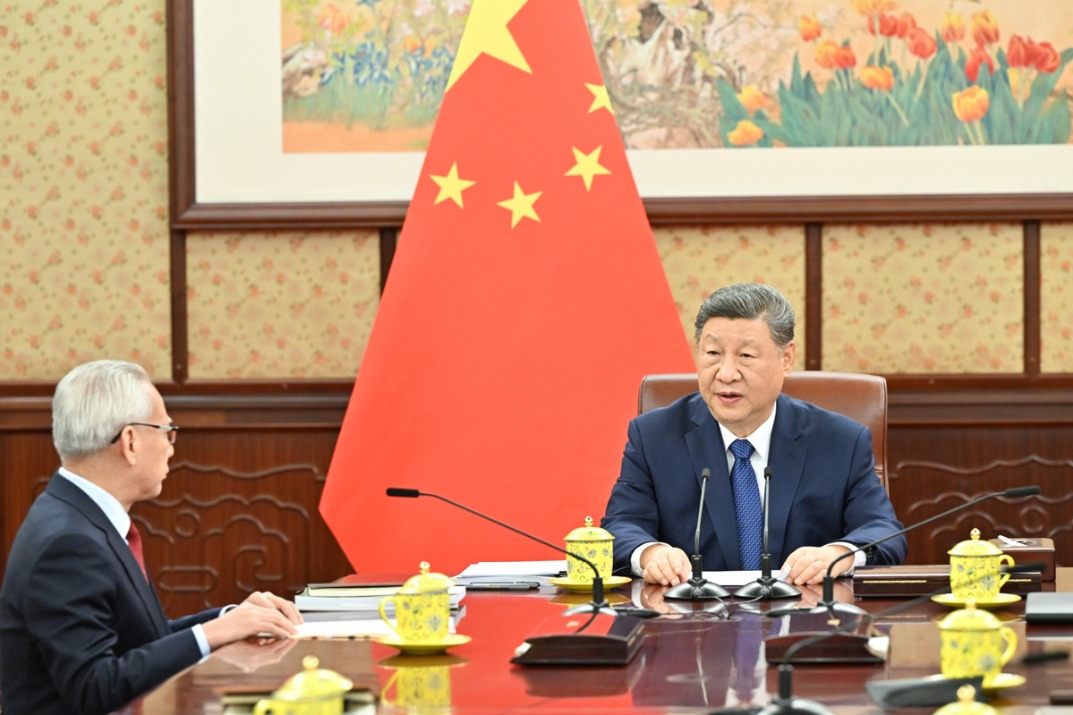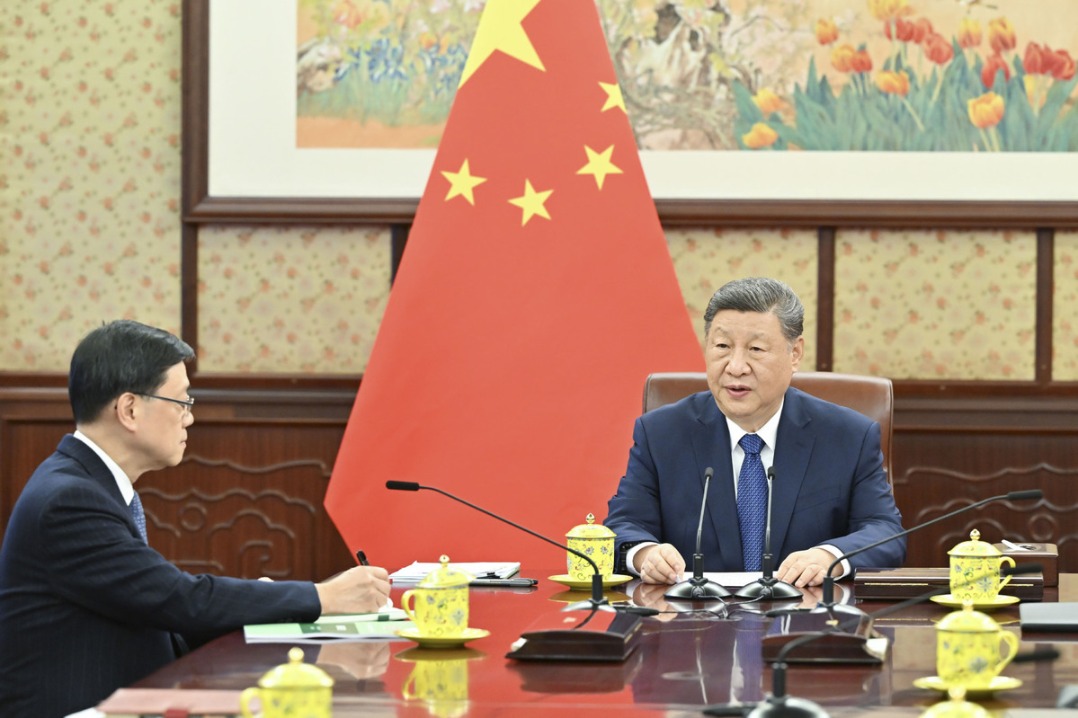Global cultural diversity on display
Chengdu forum gathers experts and practitioners from around the world to discuss future of heritage, Yang Feiyue reports.

Chinese martial arts, African tribal dances, and Brazil's Samba set off waves of applause from the audience in mid-October.
They were among the exciting performances by 47 intangible cultural heritage troupes from all over the world that kicked off the 8th International Festival of Intangible Cultural Heritage in Chengdu, capital of southwestern China's Sichuan province.
The five-day event brought together around 6,000 inheritors and performers who engaged in more than 900 performances of intangible cultural heritage from 47 countries and regions.
It was co-hosted by the Ministry of Culture and Tourism, the Sichuan government and the National Commission of the People's Republic of China for UNESCO, and aimed to showcase China's efforts to implement the Convention for the Safeguarding of the Intangible Cultural Heritage and promote traditional Chinese culture.
Five exhibitions, including those featuring intangible cultural heritage in modern life, and international craftsmanship, were staged to expose public to the cultural charm, and thus promote the inheritance of heritage.
"The current global landscape is undergoing unprecedented change,… and the protection and inheritance of traditional culture is also under tremendous pressure," Song Qiu, deputy director general of the Sichuan culture and tourism department, said at the Chengdu Forum on Intangible Cultural Heritage, a major event of the festival.
"It requires all of us to work together to protect our intangible cultural heritage," Song said, adding that local authorities are willing to use the Chengdu forum as a platform to find new opportunities, reach new consensus, and seek new developments in the protection and inheritance of cultural heritage.
This year marks an important milestone in promoting cultural diversity, as well as the 20th anniversary of the adoption of the UNESCO convention.
"The framework of the convention fully recognizes the significance of intangible cultural heritage in empowering and ensuring sustainable development," Shahbaz Khan, representative of UNESCO Multi-sectoral Regional Office for East Asia, said as he addressed the forum via a video.
"It is not just a piece of paper; it is a guiding light that directs us in protecting and promoting intangible cultural heritage."
The forum brought together experts from home and abroad to delve into the essence and value of cultural heritage, the creation of a legal system for cultural heritage protection, and to share outstanding international cases in the field of cultural heritage protection.
"The theme (of this forum) requires us to reflect on the progress we have made and the challenges we will face in the future. It urges us to innovate and find new ways to pass on knowledge and skills to the next generation, calling on us to embrace cultural diversity," Khan said.
"Our world is changing rapidly, and our traditions and customs are evolving with it. It is our responsibility to ensure that these precious elements within our cultural identity do not vanish amid the waves of modernization," he added.
The festival's host city of Chengdu has been living up to the UNESCO convention over the years, said Chen Zhiyong, the city's vice-mayor, at the forum.
"We have continued to step up efforts to protect intangible cultural heritage projects and inheritors, and have improved the management system for the intangible cultural heritage list," Chen said.
To date, the city has developed some 220 representative intangible heritage projects, 50 intangible heritage inheritance bases, and 10 intangible heritage industrial clusters.
"This has enabled the creative transformations and innovative developments of intangible cultural heritage across generations, making a positive contribution to China's intangible heritage protection efforts," Chen added.
In 2004, China joined the convention that now counts 181 states as members and which plays a positive role in delivering fruitful results in international intangible cultural heritage protection.
"The Chinese government has always attached great importance to the protection of intangible cultural heritage," Wang Chenyang, director of the intangible cultural heritage department at the Ministry of Culture and Tourism, says.
The Chengdu festival, as well as the establishment of the international intangible cultural heritage training center in Beijing for UNESCO's Asia-Pacific members, are part of China's positive contributions to the Capacity Building Strategy for World Heritage that is at the core of the sustainable implementation of the convention, Wang says.
Since the 18th National Congress of the Communist Party of China, work in preserving intangible cultural heritage has made significant progress.
"The level of intangible cultural heritage protection has continuously improved, the protection mechanisms have been established, and the role of intangible cultural heritage protection has become increasingly significant in promoting traditional Chinese culture and facilitating high-quality economic and social development," Wang says.
In 2011, the Intangible Cultural Heritage Law of the People's Republic of China was enacted and came into force, and provinces, autonomous regions, and municipalities across the country subsequently introduced regulations.
In 2021, the general offices of the Central Committee of the Communist Party of China and the State Council, China's Cabinet, released the Opinions on Further Enhancement of Protection of Intangible Cultural Heritage, which set clear goals and tasks for intangible cultural heritage protection in the new era.
"Administrative regulations and methods for recognizing and managing representative intangible cultural heritage projects and inheritors, as well as regulations for managing cultural ecology protection areas, have continued to improve," Wang says.
"The institutionalization and legal framework of intangible cultural heritage protection work have consistently progressed," he adds.
So far, the country has recognized around 100,000 intangible cultural heritages, including some 1,500 at national level, as well as 90,000 inheritors, including 3,000 national ones.
National-level cultural and ecological protection experimental zones have been established across the country, with the central government having allocated a cumulative total of 10.5 billion yuan ($1.44 billion) for national-level intangible cultural heritage protection, Wang says.
Moreover, academic programs and disciplines at around 20 universities have been set up to promote theoretical research and academic discipline development in the field.
Noriko Aikawa, former chief of the intangible cultural heritage section at UNESCO, told the forum via video that she's glad to see many are familiar with the term "intangible cultural heritage", which was quite the opposite when she started enacting the convention two decades ago.
"China played a very important role in the process of initiating and formulating the convention," Aikawa says.
She adds that it's important for all states parties to review their own convention implementation, including the status of intangible cultural heritage protection.
Wang Yunxia, a law professor at Renmin University, suggests creating an international system that covers all cultural heritage.
In addition to world cultural heritage, China has countless resources, Wang Yunxia says.
Since protection concepts for heritage are very close, Wang Yunxia says such a system can pool the power of the international community.
Wang Yunxia also suggests the addition of provisions concerning intangible cultural heritage acquisition and benefits sharing to ensure cultural treasures are not inappropriately used.
"It should make clear that intangible cultural heritage development should get content from the community of origin, state where it's coming from, and give certain profits back to the community in a proper way," Wang Yunxia says.
Hu Xiaohui, researcher at the Institute of Ethnic Literature, Chinese Academy of Social Sciences, says the convention has helped China develop a protection framework featuring county, provincial, national and international levels.
It means the international organization's global influence has reached people living in the remote areas, Hu says.
"But we still need some common principles as important foundations to understand the (UNESCO) convention," Hu says.
They include inheritors joining the decision-making for protection and management of their work, intangible cultural heritage having the same value, and cultural dialogue and mutual appreciation among intangible cultural heritage.
Duong Bich Hanh, program specialist for culture, UNESCO Multi-sectoral Regional Office for East Asia, says that UNESCO views all intangible cultural heritage as having equal value.
They are accumulated by local communities and are very important elements, says Duong.
She hopes that more communities will join and upgrade world heritage capacity building.
"This way, we can incorporate more comprehensive and diverse themes into our training programs," Duong says, adding that such themes can include how to nominate intangible cultural heritage, how to protect it amid conflicts, and how to explore relationship between living heritage and digital technology.
Wang Chenyang considers people-oriented development content to be at the core of the UNESCO convention.
"All protective measures should revolve around the inheritors, not just their status quo but long-term development," he says.
Speaking about future plans, he says China will continue to carry on Chinese traditional culture at a new horizon, show the cultural essence of Chinese civilization through intangible cultural heritage, promote cultural prosperity, and create a modern Chinese civilization.






Today's Top News
- Crossing a milestone in the journey called Sinology
- China-Russia media forum held in Beijing
- Where mobility will drive China and the West
- HK community strongly supports Lai's conviction
- Japan paying high price for PM's rhetoric
- Japan's move to mislead public firmly opposed






























